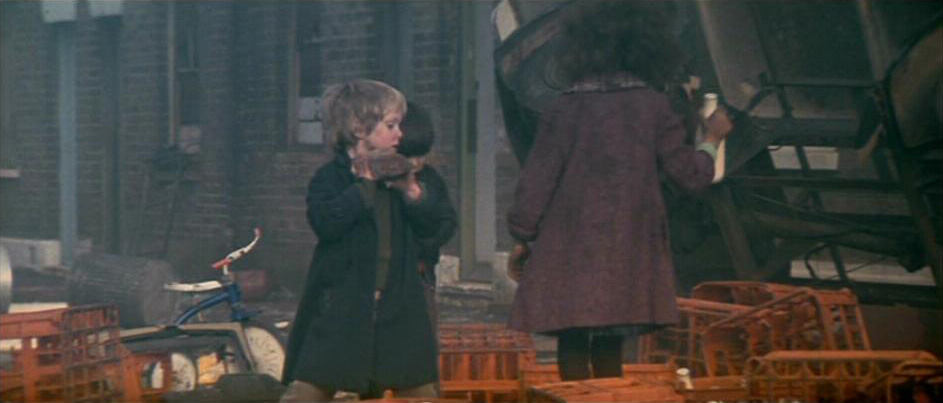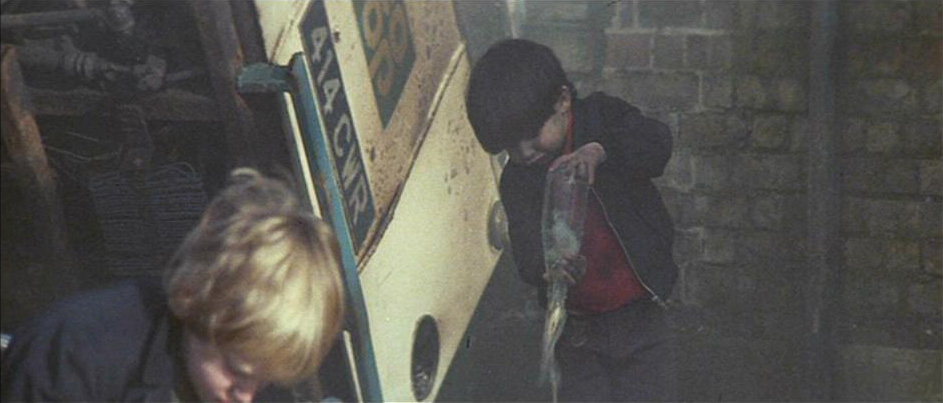Outside The Wall
[Roger Waters]All alone, or in twos,
The ones who really love you
Walk up and down outside the wall.
Some hand in hand
And some gathered together in bands.
The bleeding hearts and artists
Make their stand.
And when they've given you their all
Some stagger and fall, after all it's not easy
Banging your heart against some mad bugger's wall.
Song In A Sentence:
The Moral of the Story: Though there will almost always be personal and social barriers erected out of fear, oppression, pain, and isolation, it’s the job of every socially conscious individual and community to never rest in tearing down the walls that separate us.

L eaving aside Pink’s specific storyline, “Outside the Wall” acts as a sort of thematic rather than narrative epilogue. Thematically, this last song is very much akin to the revelatory “Bring the Boys Back Home,” which Waters felt to be the centerpiece of the album. Like the earlier song, “Outside the Wall” is about the community that comprises this world, and the personal connections that serve as the foundation for all of life. Just as “Bring the Boys Back Home” is a reminder within the story to not let anything become so important as to outweigh one’s humanity, “Outside the Wall” depicts this same view from a different perspective, from those who “walk up and down outside the wall” trying to reconnect with the loved ones trapped within. Some walk “all alone,” like Pink’s wife who tried to break through her husband’s isolating barriers, only to “stagger and fall” as a result of Pink’s continual lack of communication, turning to another man for solace and affection. Others are “gathered together in bands,” where “band” could either stand for a group of people or, in another self-reflexive statement, the actual “bleeding hearts and artists” like Pink Floyd themselves who attempt to evoke change through their art. In a way, that’s what the Wall really is: Waters and the band “banging [their] heart[s]” against the personal and social walls that stand throughout the world.

And though the cycle begins anew as the song ends, with “Isn’t this where…” signaling the end of the album, there is still hope that the cycle can be broken. For no matter how many walls are erected, there will always be people “out there” that try to break them down. It’s what Waters did after recognizing his own wall. He and his bandmates conceived and recorded an illuminating testament concerning the decay of individuality through isolation and the hopeful rise of the individual as a result of the common bond of humanity. If Pink’s story tells us anything, it’s that though the cycle of violence and oppression repeats itself, it doesn’t have to. All it takes to break that chain is a change in perspective, a realization that through it all, one is not alone.
The movie sequence for “Outside the Wall” really leans towards this hopeful message of ending these cycles of fear, violence and oppression. The scene fades from the white dust of Pink’s collapsed wall onto the day after a riot (presumably the one pictured in snippets throughout the movie) as various people go about cleaning up the debris. The camera pans down to show young kids gathering bricks and other wreckage into baskets and toy dump trucks. While some argue that the kids are merely continuing where the previous generation left off, symbolically gathering the bricks for their own psychological walls, others take away an overall optimism from the scene. As the children gather the debris, one child recoils in disgust at the smell of a Molotov cocktail, and pours the petrol from the bottle. As Waters says on the DVD commentary, the child “defuses it” and, along with his other child friends, begins to bring order to the chaos of the previous generation (the ones who started the riot). Waters continues by saying that the child “decides to build rather than destroy,” breaking the cycle of violence and oppression in an instant. It’s also interesting to note that the reworked style of the song for the movie features an orchestra and vocals similar to that of “When the Tigers Broke Free,” bringing a tidy musical resolution to the musical narrative. Though the movie begins with war, turmoil, and the negative creation of one man’s wall in that first “Tigers,” it ends with calm, the positive destruction of that very same wall, and the hope that, ultimately, those “million tear-stained eyes” – the personal and social bricks of the past – will slowly disappear from the lives of each successive generation.

What Other Floydians Have Said
"[Regarding] the boy who tastes the gas from the Molotov cocktale and he makes a face and spits it out, showing he's rejecting it. Molotovs are made for one purpose and one purpose only, to destroy, cause suffering and pain, it's a war item. The boy spitting out the gas could be symbolism that the boy is rejecting this hate and weapon. Showing that instead of building a wall of hate, he's not building a wall, or a "good" wall, trying to block out the pain of war." - Stephen Tracey
Author's Addendum: I think it's interesting that the kid doesn't even go so far as to taste it, as Stephen suggests...he simply smells it before rejecting it and pouring it out. I think it's fairly significant that there's already this degree of separation from his generation and the violence of the past, especially considering that Pink metaphorically drinks the violence and shoots it into his veins before rejecting it and throwing it back up (notice the Judge's excretion at the end of "the Trial"....as if Pink, through his inner judge, is purging himself of it all). One generation later and teh child rejects the bricks of the past by immediately pouring out the petrol bomb just after a quick sniff.
When the wall finally comes down, I think that it is important to note that the bricks themselves are not destroyed, only the mortar is. The 'bricks' of lifes experiences cannot be undone, but it is the individual that holds them together as a barrier against the world outside. I think that realizing that the bricks remain unchanged is an important point, particularly when considering the cycle intimated by work in its entirety. Even when we find our way out- find the way to tear down our own walls- the materials and propensity for rebuilding will remain. We may find ourselves re-building our own wall, but hopefully finding our way back out by tearing it down again." - Darrell Lunsford
"In the video footage accompanying 'Outside the Wall,' you mention the child who picks up the Molotov cocktail. In World War II, children were often recruited in the Allied countries to aid the war effort by gathering and sorting recyclable/re-usable items such as tires, bottles, scrap metals, and other such items. In 'Outside the Wall' we find a young boy engaged in just such a gathering effort, when he finds a Molotov cocktail, whose wick he pulls from the neck of the bottle, sniffs it, and contorting his face in a look of childlike disgust, he upends the bottle, spilling its contents onto the pavement. In the modern day, we typically tend to think of a Molotov cocktail as being filled with gasoline or diesel fuel, but the liquid in this bottle doesn't appear to have the oily consistency of diesel, and doesn't have the amber color of gasoline. This suggests a third alternative: Alcohol -- a favored fuel for these crude incendiary devices, since it's easy to obtain, and even if not, it can be easily produced using materials that are readily available virtually anywhere. (Hence the name, "Molotov cocktail".) Of course, it's plain to see that The Wall is not merely about alcoholism, and so the Molotov cocktail in this scene (being the very last image we see,) is intended to symbolize far more than mere alcohol abuse. In fact, it symbolizes both the destructive nature of war and violence, and also the self-destructive nature of the drug and alcohol abuse that were surely both symptomatic of, and a catalytic factor in, Pink's decline. Alcohol is an acquired adult taste, and children typically don't like it at all. Likewise, the violence that children see in the adult world must surely appear as madness to them. This scene, therefore, by the juxtaposition of the child and the Molotov cocktail in the frame, symbolizes childish distaste for things that, quite frankly, adults should find distasteful themselves, if they were nearly as wise as children. Inferring this dual symbolism of the Molotov cocktail, it becomes apparent that the underlying message is summed up in the wisdom of a child: "Whether this bottle of alcohol was intended to destroy yourself or someone else, the best thing to do is to wrinkle your little nose in disgust, and just dump it out. Oh, and recycle the bottle.....at least that way, it's useful for something...." - Gos

